Tianrun Chen
From Air to Wear: Personalized 3D Digital Fashion with AR/VR Immersive 3D Sketching
May 15, 2025Abstract:In the era of immersive consumer electronics, such as AR/VR headsets and smart devices, people increasingly seek ways to express their identity through virtual fashion. However, existing 3D garment design tools remain inaccessible to everyday users due to steep technical barriers and limited data. In this work, we introduce a 3D sketch-driven 3D garment generation framework that empowers ordinary users - even those without design experience - to create high-quality digital clothing through simple 3D sketches in AR/VR environments. By combining a conditional diffusion model, a sketch encoder trained in a shared latent space, and an adaptive curriculum learning strategy, our system interprets imprecise, free-hand input and produces realistic, personalized garments. To address the scarcity of training data, we also introduce KO3DClothes, a new dataset of paired 3D garments and user-created sketches. Extensive experiments and user studies confirm that our method significantly outperforms existing baselines in both fidelity and usability, demonstrating its promise for democratized fashion design on next-generation consumer platforms.
CADCrafter: Generating Computer-Aided Design Models from Unconstrained Images
Apr 10, 2025Abstract:Creating CAD digital twins from the physical world is crucial for manufacturing, design, and simulation. However, current methods typically rely on costly 3D scanning with labor-intensive post-processing. To provide a user-friendly design process, we explore the problem of reverse engineering from unconstrained real-world CAD images that can be easily captured by users of all experiences. However, the scarcity of real-world CAD data poses challenges in directly training such models. To tackle these challenges, we propose CADCrafter, an image-to-parametric CAD model generation framework that trains solely on synthetic textureless CAD data while testing on real-world images. To bridge the significant representation disparity between images and parametric CAD models, we introduce a geometry encoder to accurately capture diverse geometric features. Moreover, the texture-invariant properties of the geometric features can also facilitate the generalization to real-world scenarios. Since compiling CAD parameter sequences into explicit CAD models is a non-differentiable process, the network training inherently lacks explicit geometric supervision. To impose geometric validity constraints, we employ direct preference optimization (DPO) to fine-tune our model with the automatic code checker feedback on CAD sequence quality. Furthermore, we collected a real-world dataset, comprised of multi-view images and corresponding CAD command sequence pairs, to evaluate our method. Experimental results demonstrate that our approach can robustly handle real unconstrained CAD images, and even generalize to unseen general objects.
POPEN: Preference-Based Optimization and Ensemble for LVLM-Based Reasoning Segmentation
Apr 01, 2025Abstract:Existing LVLM-based reasoning segmentation methods often suffer from imprecise segmentation results and hallucinations in their text responses. This paper introduces POPEN, a novel framework designed to address these issues and achieve improved results. POPEN includes a preference-based optimization method to finetune the LVLM, aligning it more closely with human preferences and thereby generating better text responses and segmentation results. Additionally, POPEN introduces a preference-based ensemble method for inference, which integrates multiple outputs from the LVLM using a preference-score-based attention mechanism for refinement. To better adapt to the segmentation task, we incorporate several task-specific designs in our POPEN framework, including a new approach for collecting segmentation preference data with a curriculum learning mechanism, and a novel preference optimization loss to refine the segmentation capability of the LVLM. Experiments demonstrate that our method achieves state-of-the-art performance in reasoning segmentation, exhibiting minimal hallucination in text responses and the highest segmentation accuracy compared to previous advanced methods like LISA and PixelLM. Project page is https://lanyunzhu.site/POPEN/
Breaking the Box: Enhancing Remote Sensing Image Segmentation with Freehand Sketches
Mar 15, 2025Abstract:This work advances zero-shot interactive segmentation for remote sensing imagery through three key contributions. First, we propose a novel sketch-based prompting method, enabling users to intuitively outline objects, surpassing traditional point or box prompts. Second, we introduce LTL-Sensing, the first dataset pairing human sketches with remote sensing imagery, setting a benchmark for future research. Third, we present LTL-Net, a model featuring a multi-input prompting transport module tailored for freehand sketches. Extensive experiments show our approach significantly improves segmentation accuracy and robustness over state-of-the-art methods like SAM, fostering more intuitive human-AI collaboration in remote sensing analysis and enhancing its applications.
Syllables to Scenes: Literary-Guided Free-Viewpoint 3D Scene Synthesis from Japanese Haiku
Feb 17, 2025Abstract:In the era of the metaverse, where immersive technologies redefine human experiences, translating abstract literary concepts into navigable 3D environments presents a fundamental challenge in preserving semantic and emotional fidelity. This research introduces HaikuVerse, a novel framework for transforming poetic abstraction into spatial representation, with Japanese Haiku serving as an ideal test case due to its sophisticated encapsulation of profound emotions and imagery within minimal text. While existing text-to-3D methods struggle with nuanced interpretations, we present a literary-guided approach that synergizes traditional poetry analysis with advanced generative technologies. Our framework centers on two key innovations: (1) Hierarchical Literary-Criticism Theory Grounded Parsing (H-LCTGP), which captures both explicit imagery and implicit emotional resonance through structured semantic decomposition, and (2) Progressive Dimensional Synthesis (PDS), a multi-stage pipeline that systematically transforms poetic elements into coherent 3D scenes through sequential diffusion processes, geometric optimization, and real-time enhancement. Extensive experiments demonstrate that HaikuVerse significantly outperforms conventional text-to-3D approaches in both literary fidelity and visual quality, establishing a new paradigm for preserving cultural heritage in immersive digital spaces. Project website at: https://syllables-to-scenes.github.io/
Let Human Sketches Help: Empowering Challenging Image Segmentation Task with Freehand Sketches
Jan 31, 2025



Abstract:Sketches, with their expressive potential, allow humans to convey the essence of an object through even a rough contour. For the first time, we harness this expressive potential to improve segmentation performance in challenging tasks like camouflaged object detection (COD). Our approach introduces an innovative sketch-guided interactive segmentation framework, allowing users to intuitively annotate objects with freehand sketches (drawing a rough contour of the object) instead of the traditional bounding boxes or points used in classic interactive segmentation models like SAM. We demonstrate that sketch input can significantly improve performance in existing iterative segmentation methods, outperforming text or bounding box annotations. Additionally, we introduce key modifications to network architectures and a novel sketch augmentation technique to fully harness the power of sketch input and further boost segmentation accuracy. Remarkably, our model' s output can be directly used to train other neural networks, achieving results comparable to pixel-by-pixel annotations--while reducing annotation time by up to 120 times, which shows great potential in democratizing the annotation process and enabling model training with less reliance on resource-intensive, laborious pixel-level annotations. We also present KOSCamo+, the first freehand sketch dataset for camouflaged object detection. The dataset, code, and the labeling tool will be open sourced.
Not Every Patch is Needed: Towards a More Efficient and Effective Backbone for Video-based Person Re-identification
Jan 28, 2025



Abstract:This paper proposes a new effective and efficient plug-and-play backbone for video-based person re-identification (ReID). Conventional video-based ReID methods typically use CNN or transformer backbones to extract deep features for every position in every sampled video frame. Here, we argue that this exhaustive feature extraction could be unnecessary, since we find that different frames in a ReID video often exhibit small differences and contain many similar regions due to the relatively slight movements of human beings. Inspired by this, a more selective, efficient paradigm is explored in this paper. Specifically, we introduce a patch selection mechanism to reduce computational cost by choosing only the crucial and non-repetitive patches for feature extraction. Additionally, we present a novel network structure that generates and utilizes pseudo frame global context to address the issue of incomplete views resulting from sparse inputs. By incorporating these new designs, our backbone can achieve both high performance and low computational cost. Extensive experiments on multiple datasets show that our approach reduces the computational cost by 74\% compared to ViT-B and 28\% compared to ResNet50, while the accuracy is on par with ViT-B and outperforms ResNet50 significantly.
Distilling Diffusion Models to Efficient 3D LiDAR Scene Completion
Dec 04, 2024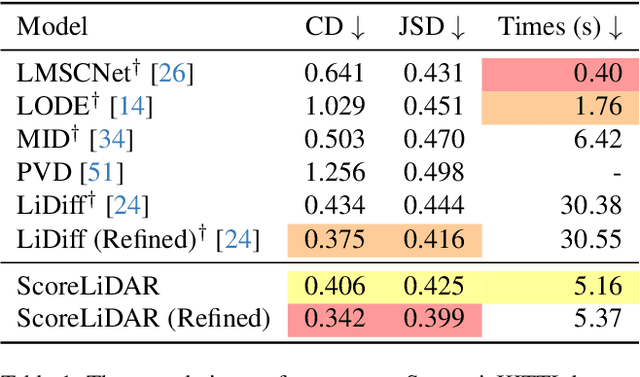
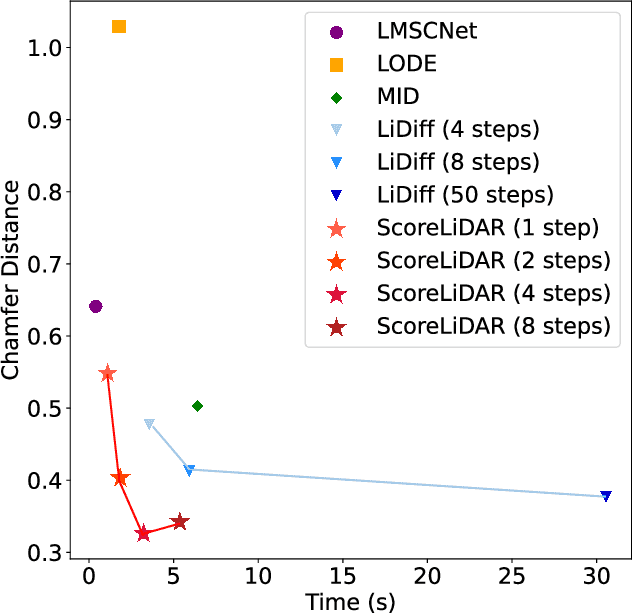
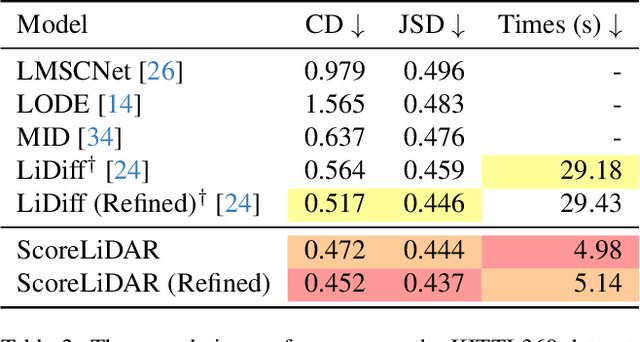

Abstract:Diffusion models have been applied to 3D LiDAR scene completion due to their strong training stability and high completion quality. However, the slow sampling speed limits the practical application of diffusion-based scene completion models since autonomous vehicles require an efficient perception of surrounding environments. This paper proposes a novel distillation method tailored for 3D LiDAR scene completion models, dubbed $\textbf{ScoreLiDAR}$, which achieves efficient yet high-quality scene completion. ScoreLiDAR enables the distilled model to sample in significantly fewer steps after distillation. To improve completion quality, we also introduce a novel $\textbf{Structural Loss}$, which encourages the distilled model to capture the geometric structure of the 3D LiDAR scene. The loss contains a scene-wise term constraining the holistic structure and a point-wise term constraining the key landmark points and their relative configuration. Extensive experiments demonstrate that ScoreLiDAR significantly accelerates the completion time from 30.55 to 5.37 seconds per frame ($>$5$\times$) on SemanticKITTI and achieves superior performance compared to state-of-the-art 3D LiDAR scene completion models. Our code is publicly available at https://github.com/happyw1nd/ScoreLiDAR.
Img2CAD: Conditioned 3D CAD Model Generation from Single Image with Structured Visual Geometry
Oct 04, 2024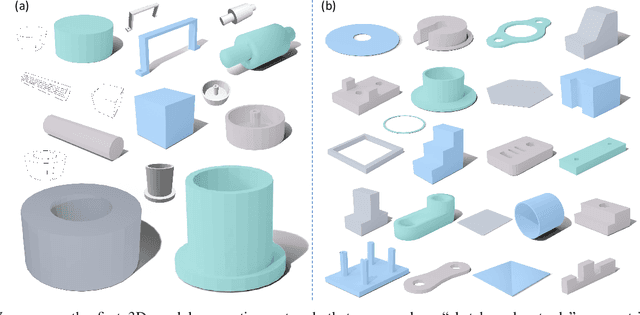
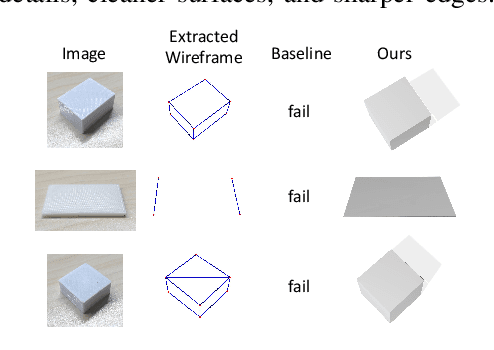
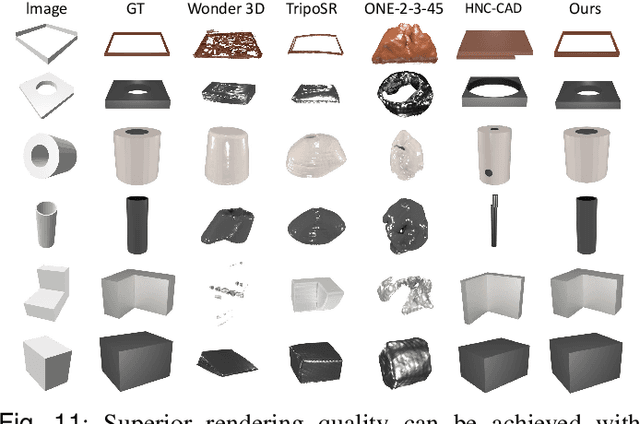

Abstract:In this paper, we propose Img2CAD, the first approach to our knowledge that uses 2D image inputs to generate CAD models with editable parameters. Unlike existing AI methods for 3D model generation using text or image inputs often rely on mesh-based representations, which are incompatible with CAD tools and lack editability and fine control, Img2CAD enables seamless integration between AI-based 3D reconstruction and CAD software. We have identified an innovative intermediate representation called Structured Visual Geometry (SVG), characterized by vectorized wireframes extracted from objects. This representation significantly enhances the performance of generating conditioned CAD models. Additionally, we introduce two new datasets to further support research in this area: ABC-mono, the largest known dataset comprising over 200,000 3D CAD models with rendered images, and KOCAD, the first dataset featuring real-world captured objects alongside their ground truth CAD models, supporting further research in conditioned CAD model generation.
SAM2-Adapter: Evaluating & Adapting Segment Anything 2 in Downstream Tasks: Camouflage, Shadow, Medical Image Segmentation, and More
Aug 08, 2024Abstract:The advent of large models, also known as foundation models, has significantly transformed the AI research landscape, with models like Segment Anything (SAM) achieving notable success in diverse image segmentation scenarios. Despite its advancements, SAM encountered limitations in handling some complex low-level segmentation tasks like camouflaged object and medical imaging. In response, in 2023, we introduced SAM-Adapter, which demonstrated improved performance on these challenging tasks. Now, with the release of Segment Anything 2 (SAM2), a successor with enhanced architecture and a larger training corpus, we reassess these challenges. This paper introduces SAM2-Adapter, the first adapter designed to overcome the persistent limitations observed in SAM2 and achieve new state-of-the-art (SOTA) results in specific downstream tasks including medical image segmentation, camouflaged (concealed) object detection, and shadow detection. SAM2-Adapter builds on the SAM-Adapter's strengths, offering enhanced generalizability and composability for diverse applications. We present extensive experimental results demonstrating SAM2-Adapter's effectiveness. We show the potential and encourage the research community to leverage the SAM2 model with our SAM2-Adapter for achieving superior segmentation outcomes. Code, pre-trained models, and data processing protocols are available at http://tianrun-chen.github.io/SAM-Adaptor/
 Add to Chrome
Add to Chrome Add to Firefox
Add to Firefox Add to Edge
Add to Edge